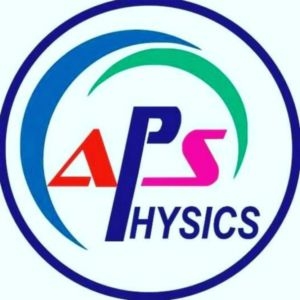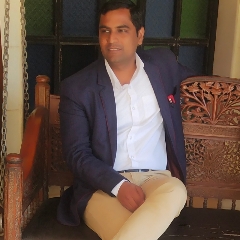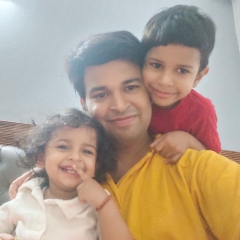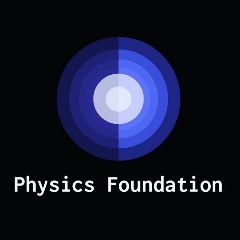Question 3 :
A ball of negligible dimensions is drowned till an apparent measured depth of 15 m in a lake. What is the depth of the lake?<br/>
Question 4 :
An object is placed at 40 cm from the optic centre of a convex lens on its principal axis. if the focal length of the lens is 24 cm, find how far from the lens the screen should be placed to obtain a well-defined image.
Question 5 :
Light moves from air into water. The light makes an angle of $47^{\circ}$ with the normal in the air. What angle will it make with the normal in the water?<br>The index of refraction for air is $1.00$.<br>The index of refraction for water is $1.33$
Question 6 :
It is first face of a prism which disperses white light. The statement is
Question 8 :
The magnifying power of a simple microscope can be increased if we use an eyepiece of
Question 9 :
If the power of a lens is $0.1\;D$, its focal length is
Question 10 :
The focal length of a convex lens is $5\,cm$,where should the object be placed to get  a real image with same size as that of object:
Question 11 :
Identify the phenomenon due to which a converging lens forms an image :
Question 12 :
Assertion: A convex lens of glass ($\mu= $ 1.5) behave as a diverging lens when immersed in carbon disulphide of higher refractive index $(\mu = 1.65)$
Reason: A diverging lens is thinner in the middle and thicker at the edges.
Question 13 :
The incident ray, the normal at the point of incidence and the refracted ray:
Question 15 :
A symmetric double convex lens is cut in two equal parts by a plane perpendicular to the principal axis. If the power of the original lens is $4 D$, the power of cut lens will be ________.
Question 16 :
While obtaining the image of a candle by a convex lens, if lower half portion of the lens is blackened to make it opaque completely, then the intensity of the image will be :
Question 17 :
A ray of light is incident normally on a plane glass slab. What will be the angle of refraction ?
Question 19 :
A thin lens is made with a material having refractive index $1.2$. Both the surfaces of the lens are convex. It is dipped in water$(\mu = 1.33)$. It will behavelike
Question 21 :
The first law of refraction states that the incident and refracted rays are in the same ________ as the normal.
Question 22 :
Fill in the blanks:The phenomenon of change in the _____of light when it passes from one transparent medium to another is refraction.
Question 23 :
The image which can not be taken on the screen is called
Question 24 :
Which color should be used to increase the resolving power of a microscope
Question 27 :
When a drop of oil is spread on a water surface, it displays beautiful colours in daylight because of :
Question 28 :
Abeam of a parallel rays is brought to a focus by convex lens. If a thin concave lens of equal focal length is joined to the convex lens, the focus will
Question 29 :
Which of the following cannot be seen by a microscope ?
Question 31 :
Two thin lenses whose powers are $+2D$ and $-4D$ respectively combine, then the power of combination is
Question 32 :
Magnifying power of simple microscope is 6, when image is formed at distance of distinct vision, the focal length of simple microscope is :
Question 33 :
If half part of a convex lens is covered, the focal length _____ change, but the intensity of the image ________.<br/>
Question 36 :
Which of the following phenomena contributes significantly to the reddish appearance of the sun at sunrise or sunset?<br/>
Question 37 :
Two lens of focal lengths $-20 cm$ and $+10 cm$ are put in combination. Find the power of the combination.
Question 44 :
When light is refracted from a surface, which of its following physical parameters does not change?
Question 45 :
The bluish colour of water in deep sea is due to:<br/>
Question 46 :
A candle placed $25 \,cm$ form a lens forms an image on a screen placed $75 \,cm$ on the other side of the lens. The focal length and type of the lens should be
Question 47 :
A focal length of a lens is 10 cm. What is power of a lens in dioptre?
Question 48 :
A ball coated with lamp black put in a glass tank containing water appears silvery white due to :<br/>
Question 49 :
The angle of minimum deviation for a prism is $40^{o}$ and the angle of the prism is $60^{o}$. The angle of incidence in this position will be
Question 50 :
Light rays from a source are incident on a glass prism of index of refraction $\mu$ and angle of prism $\alpha$. At near normal incidence, the angle of deviation of the emerging rays is
Question 51 :
A compound microscope has an objective lens of $1.0\ cm$ focal length and an eye-piece of $2.5\ cm$ of focal length. When the object is placed at $1.1\ cm$ from the objective, the final image is at the least distance of direct vision. Thus, the magnification produced is
Question 52 :
Ratio of the sine of angle of incidence to the sine of angle of reflection is:
Question 53 :
In good-quality microscopes, lens combinations are used for the objective and eyepiece instead of single lenses.
Question 54 :
A convex lens of focal length $30cm$ produce $5$ times magnified real image of an object. What is the object distance?
Question 55 :
If yellow light is refracted at angle of minimum deviation from prism, then:
Question 57 :
If the radius of curvature of the curved surface of a planoconvex lens is $50cm$, its focal length is $(\mu =1.5)$
Question 58 :
The distance of the sun form the earth is $1.5\times 10^{11}$ and its diameter is $1.40\times 10^9m.$ The diameter of the image of the sun formed by a lens of focal length $1m$ is nearly:
Question 59 :
The image of a candle flame formed by a lens is obtained on a  screen placed on the other side of the lens. If the image is three times the size of the flame and the distance between lens and image is $80\ cm$, at what distance should the candle be placed from the lens ? <br/>
Question 60 :
A convex lens of focal length f produce virtual image n times the size of the object then the distance of object from the lens is <br>
Question 61 :
Two lenses of power +12 D and -2 D are put in contact. What is their equivalent focal length?
Question 62 :
A $4.0$-cm-high object is placed at a distance of $60$ cm from a concave lens of focal length $20$ cm. Find the size of the image.
Question 63 :
The refractive index of a material of a planoconcave lens is ${5}/{3}$, the radius of curvature is $0.3 m$. The focal length of the lens in air is
Question 64 :
The linear magnification for a mirror is the ratio of the size of the image to the size of the object, and is denoted by $'m'$. Then $m$ is equal to (symbols have their usual meanings)
Question 65 :
The focal length of objective and eye piece lens of a microscope are 1.6 cm & 2.5 cm respectively. Distance between two lenses is 21.7 cm .If the final image is formed at infinity what is the linear magnification?
Question 66 :
Four lenses of focal length $+15cm,+20cm,+150cm$ and $+250cm$ are available for making an astronomical telescope. To produce the largest magnification, the focal length of the eyepiece should be
Question 67 :
A plate of thickness t made of a material of refractive index $\mu$ is placed in front of one of the slits in a double slit experiment. What should be the minimum thickness t which will make the intensity at the center of the fringe pattern zero?
Question 68 :
When a thin convex lens is put in contact with a thin concave lens of the same focal length, the resultant combination has focal length equal to :<br/>
Question 69 :
An object is placed at 20 cm in front of a concave mirror produces three times magnified real image. What is focal length of the concave mirror?
Question 70 :
An equi-biconvex lens of focal power $10D$ is cut into two equal parts perpendicular to its axis. If its refractive index is $1.5$, the radius of curvature of one of the parts is
Question 71 :
Two thin lenses have combined power of $10\ D$. When separated by $20\ cm$ their equivalent power is $6.25\ D$. Their individual powers in $D$ are
Question 72 :
A mark placed on the surface of a sphere is viewed through glass from a position directly opposite. If the diameter of the sphere is 10 cm and refractive index of glass is 1.5. The position of the image will be
Question 74 :
The radius of curvature of the convex surface of a plano-convex lens is $10 cm$. What is the focal length of the plano-convex lens? (Here $\displaystyle \mu $ = $1.5$) 
Question 75 :
In a parallel beam of white light is incident on a converging lens, the colour which is brought to focus nearest to the lens is
Question 76 :
Angle of minimum deviation for a prism of refractive index 1.5, is equal to the angle of the prism. Then the angle of the prism is : (Given $cos 41^{\circ}=0.75$)
Question 77 :
A double convex lens is made of glass of refractive index $1.5$ If its focal length is $30\ cm$, then radius of curvature of each of its curved surface is
Question 78 :
The radius of curvature of the convex surface of a planoconvex lens is 10 cm. What is the focal length of the plano-convex lens? (Here $\mu$ $= 1.5$)
Question 79 :
A lamp is hanging at a height of $40m$ from the centre of a table. If its height is increased by $10cm$, the illuminance on the table will decrease by
Question 80 :
Two lenses of power 6D and -2D are placed in contact. The power of the combination will be <br/>
Question 81 :
A convex lens of focal length $30\ cm$ and a concave lens of $10\ cm$ focal length are placed so as to have the same axis. If a parallel beam of light falling on convex lens leaves concave as a parallel beam, then the distance between two lenses will be
Question 83 :
An object is placed at 15 cm in front of convex lens of focal length 10 cm. Where shall we place a convex mirror of focal length 13 cm so that real image and object coincide? <br>
Question 84 :
Two thin lenses when in contact produce a combination of power +10 D. When they are 0.25 m apart the power is reduced to +6 D. The power of the lenses in diopters are :
Question 85 :
A ray of light strikes a glass plate at an angle of ${60}^{o}$. If the reflected and refracted rays are perpendicular to each other, the refractive index of glass is
Question 86 :
A bird is flying 12 m above the surface of pond. The apparent position of the bird as viewed by a fish 1 m below the surface is:$\left (\mu _{w}=\frac{4}{3}  \right )$<br/>
Question 87 :
A photographic plate is placed directly in front of a small diffused source in the sharp of a circular disc. It takes $12s$ to get a good exposure. If the source is rotated by $ { 60 }^{ \circ  }$ about one of its diameters, the time needed to get the same exposure will be<br/>
Question 88 :
Two convex lenses of focal lengths $f_{1}$ and $f_{2}$ form images with magnification $m_{1}$ and $m_{2}$, when used individually for an object kept at the same distance from the lenses. Then $f_{1}/f_{2}$ is:
Question 89 :
Between the primary and secondary rainbows, there is a dark band known as Alexander's dark band. This is because
Question 90 :
What is the minimum and maximum distance between the convex lens and the object for the magnification of a real image to be greater than 1.?
Question 91 :
The lateral magnification of the lens with an object located at two different positions $u_1$ and $u_2$ are $m_1$ and $m_2$, respectively. Then the focal length of the lens is :<br/>
Question 92 :
A convex lens is in contact with a concave lens.The magnitude of the ratio of their focal length is 2:3. Their equivalent focal length is 30 cm. Their individual focal lengths are (in cms)
Question 93 :
The refractive indices of glass and quartz w.r.t. air are 3/2 and 12/5 respectively. The refractive index of quartz w.r.t. glass is:
Question 94 :
Let the $\mathrm{x}-\mathrm{y}$ plane be the boundary between two transparent media. Medium 1 in $\mathrm{z}\geq 0$ has a refractive index of $\sqrt{2}$ and medium 2 with $\mathrm{z}< 0$ has a refractive index of $\sqrt{3}$. A ray of light in medium 1 given by the vector $\vec{\mathrm{A}}=6\sqrt{3}\hat{\mathrm{i}}+8\sqrt{3}\hat{\mathrm{j}} + 10\hat{\mathrm{k}}$ is incident on the plane of separation. The angle of refraction in medium 2 is<br>
Question 96 :
Calculate the index of refraction of a liquid from the following into glass:<br>Reading for the bottom of an empty breaker : 11.324 cm<br>Reading for the bottom of the beaker, when partially filled with the liquid : 11.802 cm<br>Reading for the upper level of the liquid in the beaker : 12.895 cm
Question 98 :
Which of the following is responsible for the coin appearing shallower when it is kept at the bottom of a water tank?
Question 99 :
Four lenses are made of glass and the radius of curvature of each face is given below. Which will have the greatest positive power?
Question 100 :
A double convex thin lens made of glass (refractive index $\mu=1.5$) has both radii of curvature of magnitude $20\ cm$. Incident light rays parallel to the axis of the lens will converge at a distance $L$ such that




























